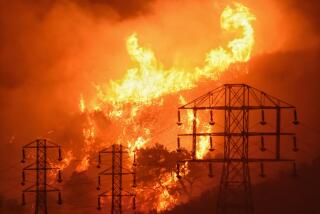It’s time for California to take over PG&E, state lawmaker says

- Share via
SACRAMENTO — A state lawmaker is making a move to turn Pacific Gas & Electric into a public utility, a potentially dramatic shift that would end decades of corporate control over California’s largest power company.
State Sen. Scott Wiener (D-San Francisco) said he introduced legislation on Monday aimed at revoking the 115-year-old company’s authority to serve its territory and directing the state to assume control of its gas and electric operations.
“This legislation is long overdue,” Wiener said at a news conference in San Francisco. “It will improve the quality of life for Californians and it will lead to safer, more reliable and affordable energy. And just to be blunt, it will put an end to the dangerous roller-coaster ride that we have been on with PG&E over the last decade.”
State officials have spent months mulling the possibility of taking over the utility and criticizing its leadership for launching widespread blackouts. But Wiener’s bill would be the first formal proposal to strip power from PG&E, which opposes the legislation and said its “facilities are not up for sale.”
“We remain firmly convinced that a government or customer takeover is not the optimal solution that will address the challenges ahead and serve the long-run interests of all customers in the communities we serve,” said James Noonan, a PG&E spokesman, in a statement.
Wiener has said he began crafting the legislation last year after the company shut off power to millions of frustrated customers mostly in Northern California in an effort to stop its power lines from sparking blazes when hot and dry conditions created an elevated wildfire risk.
In response to public pressure, PG&E started the outages after the deadliest wildfire in state history, the Camp fire, devastated Butte County in Northern California. The company filed for bankruptcy in January citing $30 billion in potential damages for causing that fire and other recent blazes.
Wiener stressed that the poorly orchestrated blackouts left low-income families with refrigerators full of spoiled food, hurt small businesses, prevented workers from earning a paycheck and endangered the lives of Californians who rely on life-saving medical equipment or refrigerated medications to survive.
“And for all of this, wildfires, blackouts, a total lack of accountability for this company, what do we get?” Wiener said. “Some of the highest electric rates in the country. Given this terrible situation with PG&E, we now have an opportunity to make real change, to try a new model.”
PG&E employees in the International Brotherhood of Electric Workers 1245 union interrupted the legislator and other speakers at the San Francisco news conference on Monday in protest of the bill. Carrying signs that said “Wiener don’t touch my pension,” they shouted “protect us” and “let the people vote!”
IBEW is a strong political force in a Capitol dominated by pro-union Democrats and the protests foreshadow a fierce lobbying battle ahead. The fight could become more difficult for opponents if Gov. Gavin Newsom weighs in and supports the proposal.
Newsom has threatened to launch his own public takeover of PG&E in response to the company’s bankruptcy restructuring plan, which he said would leave the utility with too much debt to spend the billions of dollars needed to make necessary safety improvements.
Lawmakers passed a bill last year that offers PG&E a financial incentive to settle its existing lawsuits from wildfire victims, exit bankruptcy by June 30, preserve its efforts to meet the state’s climate goals and establish a governance structure that prioritizes safety. If the company does all those things, it can dip into a multibillion-dollar state wildfire fund — supported by $10.5 billion from ratepayers and another $10.5 billion from the state’s three largest investor-owned utilities — to pay off claims for damages stemming from blazes that ignited after the bill took effect last summer.
At an event last week hosted by the Public Policy Institute of California, Newsom described the bankruptcy as a “godsend” and “extraordinary opportunity” to re-create the utility. He reiterated his willingness to turn PG&E into a public utility and said the old company “no longer exists.”
“There’s going to be a new company or the state of California takes it over,” Newsom said.
In November, Newsom tasked one of his top advisors with developing a plan to shift PG&E to public control but has yet to release any details of that proposal. It’s unclear whether Newsom’s office has consulted with Wiener about the lawmaker’s bill.
Californians appear to support calls to end PG&E’s operations as they now exist, according to a December poll conducted for the Los Angeles Times by the UC Berkeley Institute of Governmental Studies. Fewer than 1 in 8 respondents said they supported a path forward that allowed PG&E to fix its own problems and maintain its current structure.
PG&E, Southern California Edison and San Diego Gas & Electric are investor-owned utilities. If Wiener’s proposal becomes law, PG&E would operate more like the Los Angeles Department of Water and Power and the Sacramento Municipal Utility District.
Wiener’s bill would reestablish a state power authority, to be known as the California Consumer Energy and Conservation Financing Authority, that would use eminent domain to purchase all of PG&E’s shares, according the senator’s office. Under the proposal, ratepayers would shoulder the cost of acquiring the company over several decades.
The authority would lead a five-year transition from investor to public ownership in consultation with the California Public Utilities Commission. A five-member board appointed by the governor, which includes the state treasurer, would initially oversee the new utility and eventually be replaced by seven representatives from each area of the public utility’s territory. Two years after the takeover concludes, the board of the new utility would begin setting rates.
Wiener said the state would set up a public-private partnership similar to the Long Island Power Authority in New York to operate and govern the new utility.
A private contractor would take over the role of the utility operating company, called the Northern California Energy Utility Services, and employ most of PG&E’s existing 24,000 employees. Wiener’s office said the arrangement would allow workers to maintain their existing pensions and benefits, despite concerns voiced by IBEW.
Those in senior management positions would work for a smaller public agency, the Northern California Energy Utility District, that leads the company, provides oversight and makes strategic decisions, according to Wiener’s office.
Wiener’s bill would also allow local governments to split off and create smaller publicly owned utilities within a year after the state takeover is completed.
More to Read
Sign up for Essential California
The most important California stories and recommendations in your inbox every morning.
You may occasionally receive promotional content from the Los Angeles Times.











